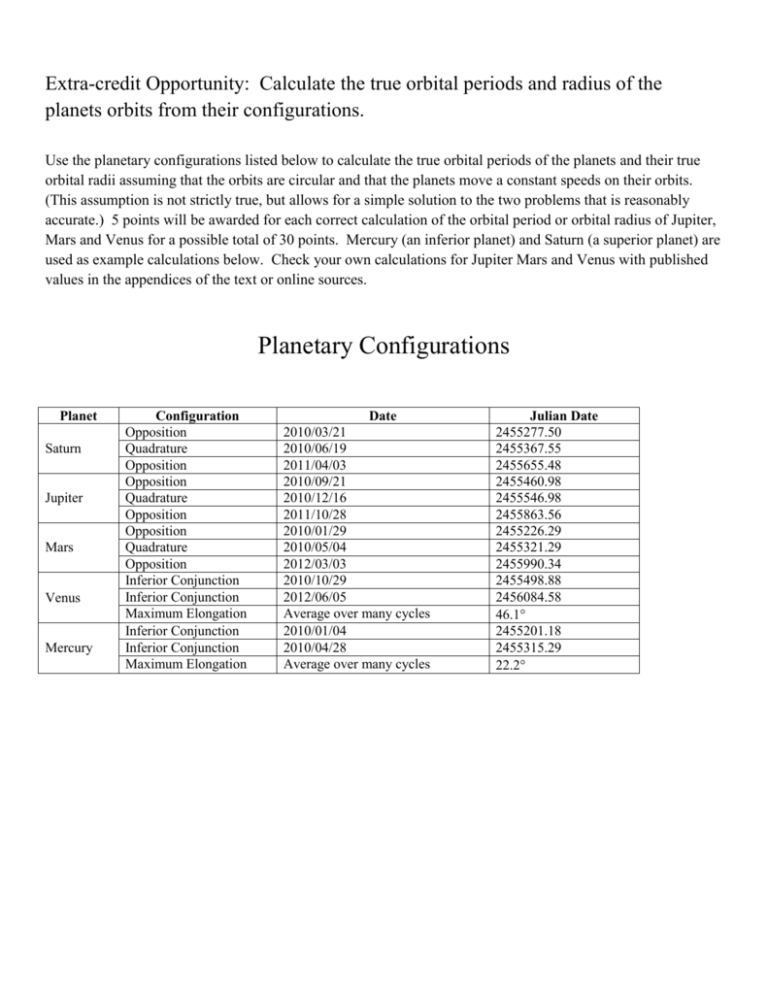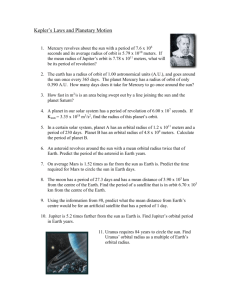Extra-credit Opportunity: Calculate the true orbital periods and
advertisement

Extra-credit Opportunity: Calculate the true orbital periods and radius of the planets orbits from their configurations. Use the planetary configurations listed below to calculate the true orbital periods of the planets and their true orbital radii assuming that the orbits are circular and that the planets move a constant speeds on their orbits. (This assumption is not strictly true, but allows for a simple solution to the two problems that is reasonably accurate.) 5 points will be awarded for each correct calculation of the orbital period or orbital radius of Jupiter, Mars and Venus for a possible total of 30 points. Mercury (an inferior planet) and Saturn (a superior planet) are used as example calculations below. Check your own calculations for Jupiter Mars and Venus with published values in the appendices of the text or online sources. Planetary Configurations Planet Saturn Jupiter Mars Venus Mercury Configuration Opposition Quadrature Opposition Opposition Quadrature Opposition Opposition Quadrature Opposition Inferior Conjunction Inferior Conjunction Maximum Elongation Inferior Conjunction Inferior Conjunction Maximum Elongation Date 2010/03/21 2010/06/19 2011/04/03 2010/09/21 2010/12/16 2011/10/28 2010/01/29 2010/05/04 2012/03/03 2010/10/29 2012/06/05 Average over many cycles 2010/01/04 2010/04/28 Average over many cycles Julian Date 2455277.50 2455367.55 2455655.48 2455460.98 2455546.98 2455863.56 2455226.29 2455321.29 2455990.34 2455498.88 2456084.58 46.1 2455201.18 2455315.29 22.2 Calculating the true orbital period of an inferior planet (Example: Mercury) 1st: Sketch out the picture that corresponds to two adjacent inferior conjunctions. Inferior planets must orbit inside the Earth’s orbit sine they can never be seen at opposition. Configuration Date Julian Date Inferior Conjunction #1 2010/01/04 2455201.18 Mercury Inferior Conjunction #2 2010/04/28 2455315.29 The time between the two conjunctions equals the difference between the Julian dates: 114.11 days which is about 1/3 of a year. #1 #1 Angle #2 #2 2nd: Calculate the angle that the Earth moved in its orbit between the two inferior conjunctions using a simple proportion. 360 114.11 days 365.241 days 112.47 degrees The Earth moved 112.47 around its orbit in the 114.11 days between inferior conjunctions of Mercury. 3rd: Calculate the angle the inferior planet moved in its orbit between the two inferior conjunctions using simple reasoning. It is reasonable to assume that Mercury moved once around the Sun plus the 112.47 of angle for a total angle of 472.47 in the 114.11 days between inferior conjunctions. Note: this assumption may be different for other inferior planets. 4th: Calculate the time required for the inferior planet to complete one orbit using a simple proportion. 472.47 360 114.11 days T days T 86.9 days Mercury requires about 86.9 days to complete one 360 orbit around the Sun. This is the true orbital period of Mercury (approximately). Calculating the true orbital period of a superior planet Calculating the true orbital period of an inferior planet (Example:Saturn) 1st: Sketch out the picture that corresponds to two adjacent inferior conjunctions. Superior planets must orbit outside the Earth’s orbit sine they are seen at opposition and conjunction. Configuration Date Julian Date Opposition 2010/03/21 2455277.50 Saturn Opposition 2011/04/03 2455655.48 The time between the two oppositions equals the difference between the Julian dates: 377.98 days which is just over 1 year. #1 #1 #2 #2 Angle is the angle the Earth moved around the Sun in 377.98 days, which will equal 360 plus the angle Saturn moved in that time period between oppositions. 2nd: Calculate the angle that the Earth moved in its orbit between the two inferior conjunctions using a simple proportion. 360 377.98 days 365.241 days 372.56 degrees The Earth moved 372.56 around its orbit in the 377.98 days between oppositions of Saturn. The Earth completed slightly more than one orbit. 3rd: Calculate the angle the superior planet moved in its orbit between the two oppositions using simple reasoning. It is reasonable to assume that Saturn moved only slightly around the Sun; 372.56 minus the 360 of angle for a total angle of 12.56 in the 377.98 days between oppositions. Note: this assumption may be different for other superior planets. 4th: Calculate the time required for the inferior planet to complete one orbit using a simple proportion. 12.56 360 377.98 days T days T 10,834 days 29.7 years Saturn requires about 29.7 years to complete one 360 orbit around the Sun. This is the true orbital period of Saturn (approximately). Calculating the true orbital radius of an inferior planet 1st: Sketch out the picture that corresponds to maximum elongation. Inferior planets must orbit inside the Earth’s orbit sine they can never be seen at opposition. Configuration Mercury Date Average over many cycles Maximum Elongation Julian Date 22.2 Mercury True Orbital Radius Maximum Elongation Angle Earth 1 AU #2 #2 2nd: Construct the right triangle with a hypotenuse of 1 AU and an interior angle equal to the maximum elongation angle. See the figure above. 3rd: Calculate the true orbital radius using the trigonometric properties of right triangles. opposite hypotenus opposite hypothenus sin(max. elongation ) sin( max. elongation ) 1 AU sin(22.2 ) 0.378 AU Mercury orbits the Sun about 0.378 AU from it.. This is the true orbital radius of Mercury (approximately). Calculating the true orbital radius of a superior planet This is the most difficult of the calculations, because you need to find two angles before you can calculate the distance. Planet Saturn Configuration Opposition #1 Quadrature #2 Date 2010/03/21 2010/06/19 Julian Date 2455277.50 2455367.55 1st: Sketch out the picture that corresponds to opposition and the following quadrature. Superior planets must orbit outside the Earth’s orbit sine they are seen at opposition and conjunction. The time between opposition and quadrature for Saturn is the difference between the Julian dates 90.05 days #1 #1 1 AU #2 #2 2nd: Construct the right triangle with a hypotenuse from the Sun to the superior planet at quadrature. See the figure above. Angle is the angle the Earth moved around the Sun in 377.98 days, which will equal 360 plus the angle Saturn moved in that time period between oppositions. 3rd: Calculate the angles that Saturn and the Earth moved through during the time between opposition and quadrature. These are the two blue arrows in the figure above. Earth 360 90.05 days 365.241 days 88.76 degrees Saturn 360 90.05 days 10,834 days 2.99 degrees 4th: Calculate the interior angle to the red triangle (i.e. the red angle). Its value is just the difference between the angle the Earth moved and the angle Saturn moved: 88.76-2.99 = 85.77 5th: Calculate the true orbital radius using the trigonometric properties of right triangles. adjacent hypotenus adjacent hypotenus cos( red interior angle) 1 AU cos(85.77 ) 13.6 AU cos( red interior angle) Saturn orbits the Sun about 13.6AU from it. This is the true orbital radius of Saturn (approximately). Note: this orbital radius is about 30% different from the current accepted value. That is due to lack of precision in our dates for the quadrature. The red interior angle should be 83.9 . The difference is a 2 day error in identifying quadrature.




